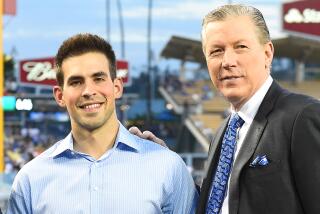The real stain on the game
Let’s see if I have this straight: we have the most significant steroids-related baseball story since the feds raided BALCO and it received less attention than the 2 1/2 -year-old stains on Curt Schilling’s sock?
On Friday former New York Mets clubhouse attendant Kirk Radomski pleaded guilty to distributing performance-enhancing drugs to what a U.S. attorney said were “dozens” of major league players and their associates, and it was lost amid the relentless buildup to the NFL draft, the NBA playoffs and, yes, the ridiculous non-story of the true origins of the red stain on the sock of a Red Sox pitcher.
The problem with the Radomski report is it doesn’t name names. Names mean headlines. Everyone focuses the steroids debate on marquee monikers such as Barry Bonds and Mark McGwire, even though they never had a positive drug test or had charges brought against them.
What people don’t realize is this latest news is about Bonds and McGwire -- specifically their Hall of Fame candidacies. If people believe those two used steroids, it’s hard to say they gained a competitive advantage over their peers if everyone else was doing it. When the Radomski details come out it could show just how widespread performance-enhancing drugs were in baseball during the 10-year period (starting in 1995) in which he admitted supplying them to players.
The real damage of the steroids era wasn’t the changes at the top of the record books. It was at the bottom of the rosters, where people who stayed clean lost jobs to players who cheated. Bonds, McGwire and any other superstar you name were going to be great regardless of the substances they used. It was the belief that every average player needed them for that little edge that was dangerous, and the type of mentality that could trickle down to high school kids.
*
It was bad enough when the NFL draft was just overblown and overanalyzed. Now it’s turned into a bad reality show: Sufferin’ Quarterbacks (as Sylvester the Cat might say).
We went through it last year with Matt Leinart, and this year we had to watch every sigh and slumped shoulder by Brady Quinn until the Cleveland Browns pulled a trade to take him with the 22nd pick.
The most egregious BradyCam moment was when they showed his reaction after the Arizona Cardinals took offensive lineman Levi Brown with the fifth pick. The Cardinals took Leinart just last year. Did anyone expect them to take another quarterback? Was Quinn supposed to be stunned that the Cardinals passed on him?
Later, ESPN showed a montage of disappointed quarterbacks from recent drafts, including Ben Roethlisberger, Aaron Rodgers and Leinart. The boulevard of broken dreams.
It was getting so bad that NFL Commissioner Roger Goodell invited Quinn to his area backstage to get a little privacy. All 115 broadcasters on ESPN praised Goodell for getting him away from the cameras. Then ESPN sent a camera into Goodell’s area so Suzy Kolber could interview Quinn.
When all was said and done, Quinn was selected in the first round of the NFL draft by the team he favored while growing up. I don’t know about you, but that was a lot better than anything that happened to me on Saturday.
Two good developments from the draft coverage:
1) Tony Kornheiser seemed much more like himself with Ron Jaworski sitting next to him than he ever did with Joe Theismann. I’m looking forward to Monday Night Football next season. With Tony freely cracking jokes and Jaws breaking down plays they could finally have the booth chemistry the franchise has been searching for since, oh, 1985.
2) Steve Spurrier in a national commercial, answering his phone as “the ball coach” and signing off “click, clack.” If we have to be subjected to a stream of Mike Krzyzewski ads every March, we should at least be entitled to more Spurrier every April.
*
It’s looking like nothing can prevent the end of the Eastview Little League’s run at the site it has occupied for more than four decades. On the same day my column about its predicament ran last week, the league received an eviction notice from Target that said the fields will indeed be torn down starting July 1 to begin construction of a new store.
Eastview President David Stanovich said the league’s board will meet with Target executives on May 10 and he hopes to persuade them to allow the fields to stay open until a temporary replacement can be created in San Pedro. The site being presented as a replacement is on land controlled by the Port of Los Angeles, which means both the port authority and the state would have to approve any changes -- legislative roadblocks on top of the construction time.
“If they are confident that these fields will be built by January of 2008, I don’t think six months of them leaving the [current] field would hurt their construction,” Stanovich said. “Eventually we’re trying to find a permanent home, which hasn’t materialized yet.”
--
J.A. Adande can be reached at j.a.adande@latimes.com. To read previous columns by Adande, go to latimes.com/adande.
More to Read
Go beyond the scoreboard
Get the latest on L.A.'s teams in the daily Sports Report newsletter.
You may occasionally receive promotional content from the Los Angeles Times.










